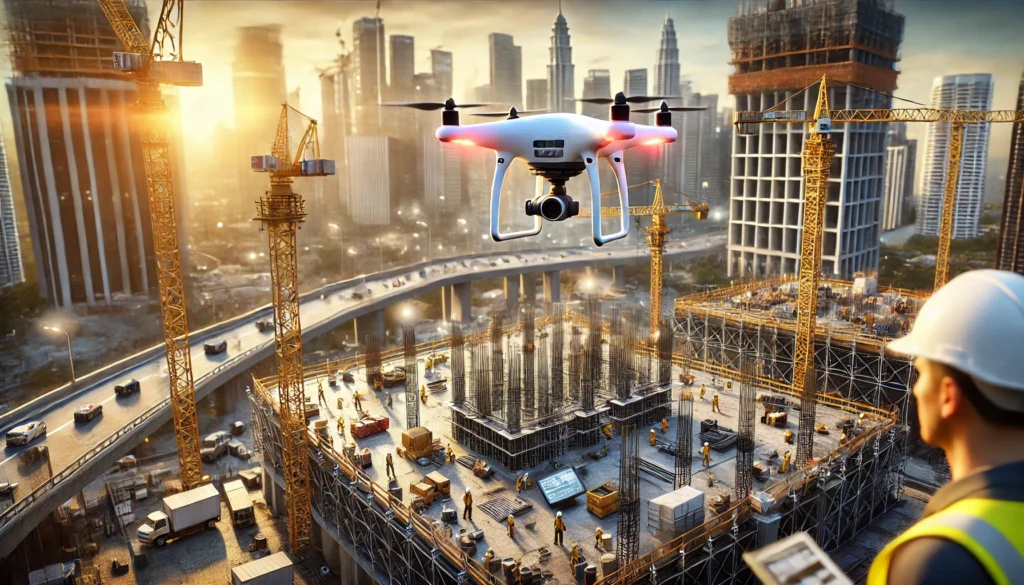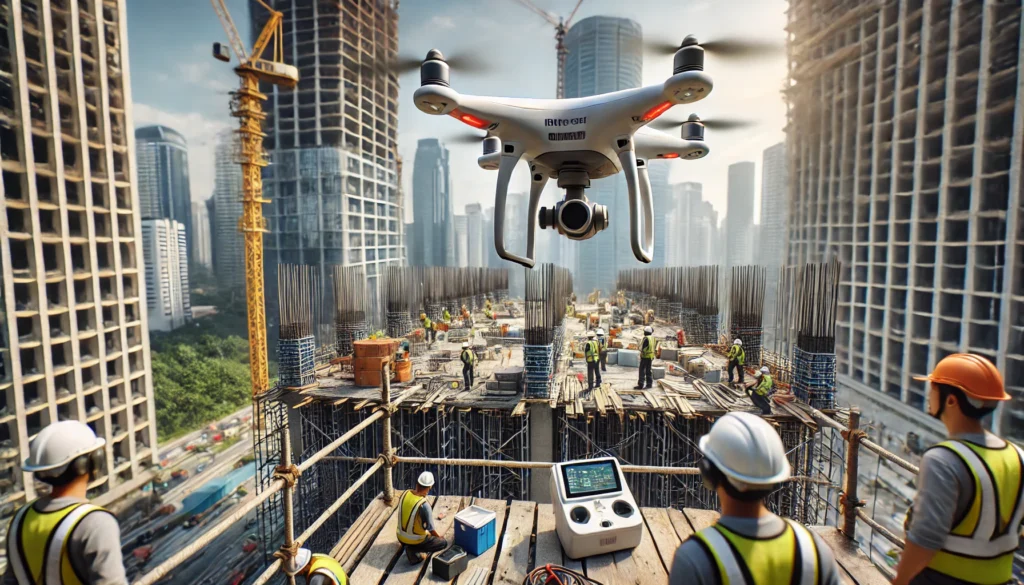The construction industry is witnessing a transformative wave of technological advancements, with drones emerging as a critical tool for improving efficiency, safety, and accuracy. In Malaysia, where construction projects range from urban skyscrapers to sprawling infrastructure developments, the adoption of drone technology is growing rapidly. This comprehensive guide delves into the role of drones in the Malaysian construction sector, highlighting their benefits, challenges, and the trends shaping their future use.
Understanding Drone Technology in Construction
Drones, or Unmanned Aerial Vehicles (UAVs), are equipped with advanced sensors, cameras, and software systems that enable real-time data collection and analysis. In construction, drones are used for a variety of purposes, such as site surveys, progress monitoring, and safety inspections.
Key Features of Construction Drones:
- High-Resolution Cameras: Capture detailed aerial imagery and videos.
- LiDAR Sensors: Generate 3D maps and models of construction sites.
- Thermal Imaging: Detect heat patterns to identify structural issues.
- Automated Flight Software: Execute pre-programmed flight paths for consistent data collection.
Drones offer a bird’s-eye view of construction sites, providing insights that would be challenging to obtain through traditional methods.
The Benefits of Drone Technology in Construction
The integration of drones in Malaysia’s construction industry brings a host of benefits that enhance project efficiency, safety, and decision-making.
Improved Site Surveys and Mapping
Traditional site surveys can be time-consuming and labor-intensive. Drones simplify this process by:
- Collecting accurate topographic data in a fraction of the time.
- Creating detailed 3D maps and orthomosaic images for site planning.
- Reducing the cost of surveying large or remote areas.
Enhanced Safety Inspections
Drones improve safety by minimizing the need for workers to access hazardous areas. Key advantages include:
- Inspecting high-risk areas like scaffolding, rooftops, and confined spaces.
- Detecting structural issues through thermal imaging and high-resolution imagery.
- Reducing the risk of accidents by conducting remote inspections.
Efficient Progress Monitoring
Construction managers can use drones to track project progress in real time. Benefits include:
- Capturing periodic aerial images to compare actual progress with project timelines.
- Sharing visual updates with stakeholders to ensure transparency.
- Identifying bottlenecks or delays early in the construction process.
Cost Savings
By automating tasks such as inspections and surveys, drones help reduce labor and equipment costs. Additionally, the high-quality data they provide can prevent costly errors and rework.
Environmental Impact Assessment
Drones are instrumental in assessing the environmental impact of construction projects. They can:
- Monitor vegetation and soil conditions.
- Evaluate water drainage patterns.
- Ensure compliance with environmental regulations.
Challenges in Adopting Drone Technology
While the benefits of drones are significant, their adoption in Malaysia’s construction industry comes with challenges that contractors must address.
Regulatory Compliance
The use of drones in Malaysia is regulated by the Civil Aviation Authority of Malaysia (CAAM). Key requirements include:
- Obtaining permits for commercial drone operations.
- Adhering to no-fly zone restrictions near airports and sensitive areas.
- Ensuring that drone operators are certified and trained.
Initial Investment Costs
Although drones reduce costs in the long term, the upfront investment in equipment, software, and training can be prohibitive for small to medium-sized contractors.
Data Management
The vast amount of data generated by drones requires proper storage, processing, and analysis. Contractors must invest in robust data management systems and skilled personnel to derive actionable insights.
Weather Dependence
Drones are sensitive to weather conditions such as rain, strong winds, and poor visibility, which can disrupt operations and delay data collection.
Limited Battery Life
Most drones have limited flight times, typically ranging from 20 to 40 minutes, which may necessitate multiple flights for larger construction sites.
Drone Technology in Malaysia: Legal and Regulatory Framework
In Malaysia, the use of drones for commercial purposes, including construction, is governed by CAAM under the Civil Aviation Regulations 2016. Here’s what contractors need to know:
Registration and Licensing
- All drones used for commercial purposes must be registered with CAAM.
- Operators must hold a Remote Pilot License (RPL) issued by CAAM.
Operational Limitations
- Drones must not fly higher than 400 feet above ground level.
- Operations are restricted to daylight hours and require line-of-sight visibility.
Restricted Areas
- Drones are prohibited from flying near airports, military zones, and densely populated areas without special permissions.
Insurance Requirements
- Commercial drone operators are required to have liability insurance to cover potential damages or injuries.
Compliance with these regulations is essential to avoid fines and legal complications.

Future Trends in Drone Technology for Construction
The future of drone technology in Malaysia’s construction industry looks promising, with advancements likely to expand their capabilities and applications.
Integration with Building Information Modeling (BIM)
Drones are increasingly being integrated with BIM systems to:
- Provide real-time updates on project progress.
- Enhance 3D modeling accuracy with aerial data.
- Streamline collaboration among project stakeholders.
Use of AI and Machine Learning
Artificial intelligence and machine learning are enhancing drone capabilities by:
- Automating defect detection in structures.
- Predicting maintenance needs based on data patterns.
- Optimizing flight paths for better data collection.
Autonomous Drones
Fully autonomous drones equipped with advanced sensors and AI algorithms will reduce the need for human intervention. These drones can:
- Conduct inspections and surveys on pre-programmed schedules.
- Adapt to changes in site conditions without manual adjustments.
Drone Swarms
The use of multiple drones working in tandem, or “drone swarms,” will enable faster and more comprehensive site coverage. This technology is particularly useful for large infrastructure projects.
Hybrid Power Solutions
Developments in hybrid power systems are expected to extend drone flight times, making them more suitable for large-scale projects.
Pro Inspect Solution: Drone Inspection Services in Malaysia
Pro Inspect Solution offers cutting-edge drone inspection services tailored to meet the needs of Malaysia’s construction industry. By leveraging advanced drone technology, we help contractors enhance safety, efficiency, and compliance.
Services Offered by Pro Inspect Solution
- Aerial Site Surveys
- High-resolution mapping and topographic data collection.
- Fast and accurate site assessments for planning and design.
- Safety and Structural Inspections
- Remote inspections of high-risk areas, reducing worker exposure.
- Detection of structural issues using thermal imaging.
- Progress Monitoring
- Regular drone flights to track project progress and identify delays.
- Visual updates for stakeholders through high-quality imagery and videos.
- Environmental Impact Assessments
- Monitoring vegetation, soil conditions, and water patterns.
- Ensuring compliance with environmental regulations.
- Data Analysis and Reporting
- Advanced processing of drone-collected data to generate actionable insights.
- Customizable reports aligned with client requirements.
Benefits of Partnering with Pro Inspect Solution
- Expertise: Our team of certified drone operators and inspectors ensures precision and compliance.
- Cost-Effectiveness: Reduce operational costs while enhancing project efficiency.
- Regulatory Compliance: We handle all legal and regulatory requirements for drone operations.
- State-of-the-Art Technology: Access the latest drones and software for superior results.
Visit Pro Inspect Solution to learn more about our services and how we can assist your construction projects.
Conclusion
Drone technology is transforming Malaysia’s construction industry by offering unparalleled efficiency, safety, and accuracy. While challenges like regulatory compliance and initial costs exist, the benefits far outweigh them, making drones a valuable asset for modern construction projects.
By embracing advancements such as AI integration, autonomous drones, and hybrid power systems, contractors can stay ahead in this competitive industry. Partnering with experts like Pro Inspect Solution ensures seamless implementation of drone technology, helping you achieve your project goals effectively.
FAQ Drones in Construction
What are the key benefits of drones in construction?
Drones enhance site surveys, improve safety, monitor project progress, save costs, and assist in environmental impact assessments.
What regulations govern drone use in Malaysia?
Drone operations in Malaysia are regulated by the Civil Aviation Authority of Malaysia (CAAM), which requires permits, licenses, and adherence to no-fly zone restrictions.
How can Pro Inspect Solution help with drone inspections?
Pro Inspect Solution provides end-to-end drone inspection services, including site surveys, safety inspections, and progress monitoring, ensuring compliance with all regulations.
What are the challenges of using drones in construction?
Challenges include regulatory compliance, initial investment costs, weather dependence, and managing large volumes of data.
What is the future of drone technology in construction?
Future advancements include integration with BIM, AI-driven analytics, autonomous drones, drone swarms, and extended flight capabilities through hybrid power systems.


